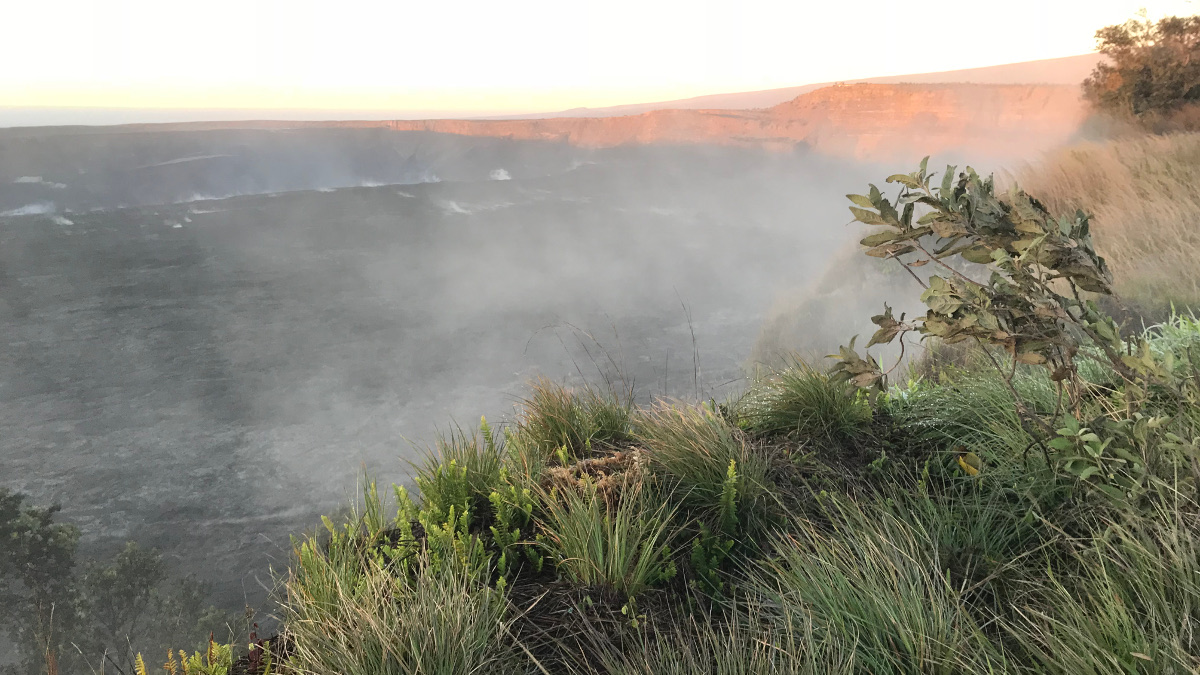(BIVN) – Amid the dramatic changes at the summit of Kīlauea Volcano that occurred this summer, scientists recently ascertained that the groundwater at the summit is 7 feet lower than it was in March, before the eruption of 2018.
The story of how the USGS Hawaiian Volcano Observatory measured that water level is the topic of this week’s Volcano Watch article. The story is told through the eyes of HVO’s Physical Science Technician, Frank Younger.
 USGS Hawaiian Volcano Observatory
USGS Hawaiian Volcano Observatoryon December 20, 2018
A Field Trip to the Mountain of Water
The field day begins with a summit weather check at first light. It is a reflective moment at 6:15 AM atop Kīlauea Volcano, and the fumarole cracks are steaming like the coffee from my thermos. The weather at Halemaʻumaʻu crater is cool and dry, with light trade winds from the northeast. We hope for these mornings.
I text my workmates at the U.S. Geological Survey–Hawaiian Volcano Observatory (HVO) in Hilo. The plans are a “go”—our sampling crew is heading to Keller Well. My checklist for today’s field work reads: water, rain jacket, extra-long tape measure….
I am one of a team of volcano scientists and technicians making this trip. Our destination is a 1,262 m (4,140 ft) deep borehole, locally called Keller Well, that is the only one of its kind on Kīlauea’s summit. Since it was drilled in 1973, it has provided researchers with a view into the hydrology and history of an active volcano. Our mission today is to measure the groundwater level in the well, 506 m (1,660 ft) beneath the surface (where the groundwater level was when it was last measured 9 months ago) and to bring up a scalding hot water sample. I continue checking my list: 2 m (6 ft) metal sampler tube, clean sample bottles….
My HVO and USGS Volcano Science Center colleagues and I will be accessing a restricted area of Hawai’i Volcanoes National Park. We check our safety gear: helmets, respirators, SO2 sensor badges, satellite tracker, and our National Park Service permit. Keller Well, located in the southern portion of the Kīlauea caldera, sits at 1,102 m (3,615 ft) above sea level. The rim of the Halemaʻumaʻu lava lake of 2008–2018 used to be about 1 km (0.62 mi) to the north.
Distance from rim to well narrowed dramatically during the eruption of this past summer, as caldera collapse explosions shook Halemaʻumaʻu and the lava lake drained out of sight. The steaming pit is now nearly a cubic kilometer (0.25 cu mi) larger, the rocky bottom is 500 m (1,640 ft) deeper, and the crater rim has expanded about 250 m (820 ft) toward the wellhead. Across the chasm from Keller Well, the evacuated HVO tower looms empty; a silent host of cameras keeping watch over Kīlauea. We will find out today if Keller Well has survived the 2018 eruption. Will it continue to yield data on Kīlauea’s hydrothermal depths, or has the story been pinched off?
At the wellhead, a capped stub of pipe protrudes from the barren, ash-caked landscape. We set up the large tape measure reel and lower the electric continuity sensor into the well. It descends quickly as we spool out the calibrated graduations into the darkness below. Down through the porous rock, we follow the path of a fallen raindrop, moving through varied layers. Some are highly porous, while others are choked by mineralization that formed as liquid water was converted to steam by geothermal heat. Ash layers confine the free movement of the groundwater, while cracks and other voids can conduct large flows.
Suddenly, the alarm at the surface buzzes madly, signaling the tape circuit is complete. The downhole sensor has reached the water table! We have arrived at the Mountain of Water.
Hidden beneath the surface of the volcano island, this mountain within has a character all its own. Its topography is constantly changing, seeking balance between discharge and recharge, pressure and heat. Beneath Kīlauea’s summit, the altitude of the water mountain is remarkably high compared to nearby areas outside the volcanic rift zones. We measure the tape, 508 m (1,667 ft) to the reference mark on the wellhead; the groundwater is 2.1m (7 ft) lower than it was in March, before the eruption of 2018.
The Mountain of Water’s composition is diverse. It is fresh and salt, liquid and steam, and it carries an abundance of dissolved chemicals. We withdraw the sampler, kettle-hot, and carefully bottle the sample for laboratory analyses of sulfate (SO4), chloride (Cl), sodium (Na), and potassium (K).
Today’s field work marks one new data point in a long series of observations at Keller Well. Only time and concerted effort will reveal its context within the larger story.


by Big Island Video News4:02 pm
on at
STORY SUMMARY
HAWAIʻI VOLCANOES NATIONAL PARK - A USGS Hawaiian Volcano Observatory scientist writes about his field trip to the Mountain of Water on Kilauea.